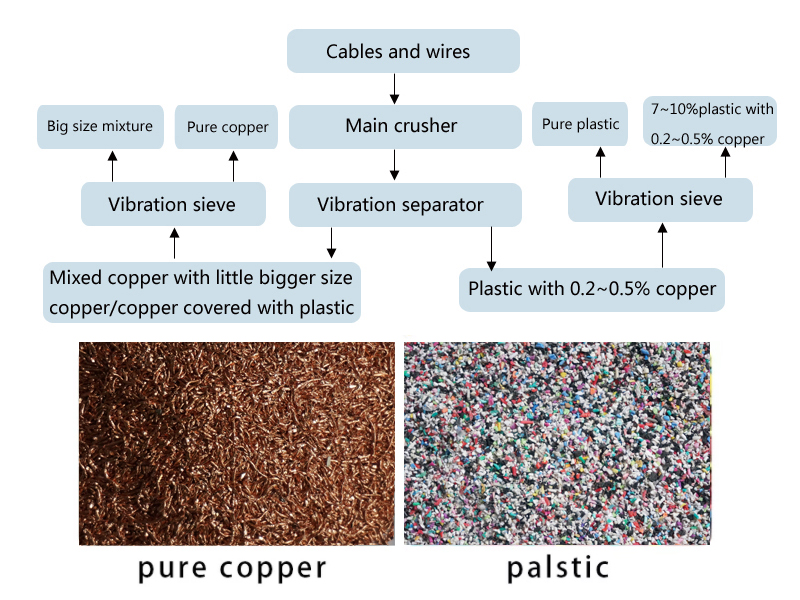In the waste wire crushing workshop, screening is mainly used as an auxiliary process. The screening before using a scrap copper wire granulator machine for crushing is called pre screening, and the screening of the products obtained after the crushing operation is called inspection screening. Grinding plays an important role in the treatment and utilization of waste electrical wires. Grinding generally has three purposes: first, to crush the material in the final stage to separate various components and create conditions for the next step of sorting; second, to grind various waste raw materials while playing a role in mixing them evenly; third, to produce waste powder, increase the specific surface area of the material, and create conditions for shortening the chemical reaction time of the material. The gravity sorting mechanism in the scrap copper wire granulator machine system is a beneficiation method that adds materials to active or flowing media, and the difference in particle density leads to different movement speeds or trajectories, resulting in the separation of products with different densities. The commonly used media in gravity separation process include water, air, and suspension. The re selection methods can be divided into heavy medium selection, jigging selection, shaking table selection, and chute selection. Broadly speaking, grading and ore washing also belong to the category of gravity separation. The advantages of re selection are low production cost, wide particle size range of processed materials, and less environmental pollution. Flotation is also an important process method in the resource utilization technology of waste electric wires, mainly used to separate small solid particles that are not easily separated by gravity separation. The principle of flotation is to use the physical and chemical characteristics of the metal and plastic surfaces in the waste line, add various flotation agents under certain conditions, and carry out mechanical agitation to make Suspended solids attach to air bubbles or flotation agents, float to the water surface with bubbles, and then recover them.

The magnetic fluid sorting in the copper rice machine system refers to a stable dispersed liquid that can magnetize under the combined action of a magnetic field or magnetic field and electric field, presenting a phenomenon of aggravation, and thus having a magnetic buoyancy effect on particles. Magnetic fluid usually adopts strong electrolyte solution, Paramagnetism solution and magnetic colloidal suspension. The density of the magnetic fluid that appears to have increased is called apparent density, which is several times higher than the density of the medium. The apparent density of magnetic fluids can be adjusted arbitrarily by changing the intensity of the external magnetic field, magnetic field gradient, and electric field intensity. The waste wires crushed by the copper rice machine can be placed in a magnetic fluid, and any relative density of metals and plastics can be effectively sorted by adjusting the apparent density of the magnetic fluid. Magnetic fluid separation is a separation process that combines gravity and magnetic separation. Materials are separated according to density difference in heavy medium, similar to gravity separation; In the magnetic field, the separation is based on the magnetic difference of materials, which is similar to magnetic separation. Therefore, magnetic and non-magnetic materials can be separated, and non-magnetic materials can also be separated according to the density difference. The magnetic fluid separation method plays a special role in the treatment and utilization of waste wires. It can not only separate various wires and cables, but also separate metals such as aluminum, copper, zinc, and lead from other waste materials. For example, by placing aluminum rich waste that has undergone screening, wind sorting, and magnetic separation into a pool, the density of the aqueous solution is adjusted to allow aluminum to surface while other substances still settle at the bottom of the pool. This is the most commonly used aluminum recycling method.


